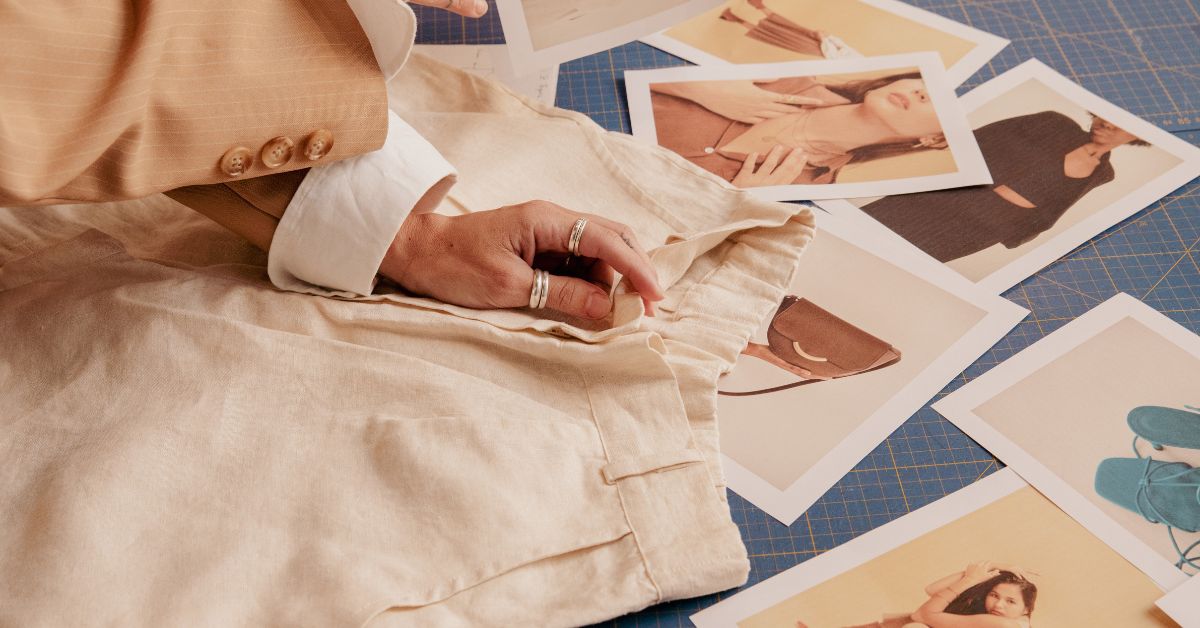Starting a career in fashion designing after the 12th brings up opportunities for creativity and innovation. Having the correct education and skills, you can turn your enthusiasm for fashion into a lucrative profession. Addressing several courses and possibilities will set the foundation for a successful profession in this competitive industry.
In this article, we will delve into the different fashion designing courses after 12th, fashion career options after 12th, top fashion institutes, and more. So, if you are passionate about this industry and want to start a career in the fashion industry, continue reading this article.
Table of Content
- Why Choose a Career in Fashion Designing After 12th?
- Educational Paths for Fashion Designing
- Top Fashion Design Institutes
- Course Structure and Specializations
- Skills Needed for Fashion Designing
- Building a Strong Portfolio
- Gaining Practical Experience
- Exploring Career Opportunities in Fashion Designing
- Starting Your Own Fashion Label
- Challenges and How to Overcome Them
- Conclusion
Why Choose a Career in Fashion Designing After 12th?
Picking a profession in fashion designing after 12th brings an innovative and exciting pathway. It helps you to showcase your artistic skills while being up to date with the trends in the industry. The industry brings along various opportunities, from designing garments to overseeing fashion shows. With the help of the correct education and skills, you can build for yourself a lucrative career, fulfillment in work, and achieve fame. Starting early gives you an edge, enabling you to grow and adapt in this dynamic field.
Educational Paths for Fashion Designing
To start a career in fashion design after 12th, choosing the right educational path is crucial. Here are some options:
- Diploma Courses
- Undergraduate Degree Programs
- Certificate Courses
Diploma Courses
These are short-term courses in fashion design for a duration of about one to 2 years. They are more focused on developing industry-relevant skills and provide a strong foundation in fashion basics, making them great for students wanting to get into the industry early.
Undergraduate Degree Programs
These are the types of courses that will last for a longer duration of time ranging from three to four years and offer an in-depth education in fashion design. They cover various topics, including the theory of design, fabrics, and business management, giving a well-rounded education that molds students’ part in the fashion design industry.
Certificate Courses
Certification courses are typically shorter and more specialized, focused on specific topics such as fashion illustration or digital design. They are ideal for students who wish to obtain expertise in a certain area or improve their abilities while pursuing other educational goals.
Top Fashion Design Institutes
Having to choose the correct fashion design institute that will help you achieve your goals can be a tough decision to make. Choosing the correct fashion design institute can make a significant impact on your career.
Here are a few top fashion design institutes, their admission requirements, and the course structure:
- National and International Institutes
- Admission Requirements
- Course Structure and Specializations
National and International Institutes
Here are the top national and international institutes for fashion design:
National institutes:
- AAFT
- AAFT Online
- Pearl Academy
- National Institute of Fashion Technology (NIFT)
- Symbiosis Institute of Design
- International Institutes:
- London College of Fashion
- Central Saint Martins
- Parsons School of Design
- Royal Academy of Fine Arts (Antwerp)
- Fashion Institute of Technology (FIT)
Admission Requirements
Admission requirements can be different for all institutes. Generally, you might need a diploma, a portfolio that shows your innovative work, and mostly an entrance exam or interview. Some institutes also look for a good command of language like English and a solid passion for fashion.
Course Structure and Specializations
Fashion design programs cover topics such as fashion sketches, textiles, and apparel making. Fashion marketing, eco-friendly fashion, and digital fashion design are the popular options for specialization. These numerous specialties enable students to adapt their education to their professional aspirations.
Skills Needed for Fashion Designing
To be successful in the world of fashion design, some critical skills are necessary. These skills not only enhance your design skills but also help assist you to develop in this competitive industry.
Here are some skills you need to master to be successful in the fashion industry:
- Creativity and Artistic Skills
- Technical Skills
- Communication and Networking
- Business Acumen
Creativity and Artistic Skills: To create or make an appealing design, fashion designers need to have a solid sense of creativity and artistic skills. This includes a knack for color, appearance, and patterns.
Technical Skills: Efficiency in using design tools, sewing machines, and knowledge of materials are important for transforming innovative ideas into final products.
Communication and Networking: It is important when working with clients, members of the team, and experts from the industry to have good communication skills and networking skills. Networking can lead to new opportunities in the industry also helping you grow in your professional life.
Business Acumen: To run a lucrative and successful fashion business it is important to understand the different sides of business like sales, marketing, and brand management.
Building a Strong Portfolio
A good portfolio is an important part of a fashion designer’s career. A portfolio showcases your skills, style, and innovation to potential employers or clients. Here is why a portfolio is important for your career and the steps to creating an impactful portfolio.
Importance of Portfolio
A portfolio is a personal exhibition of your greatest work. It allows potential employers and clients to see your design style and talents. A great portfolio might differentiate you from other candidates and bring you new employment options. It is vital for showcasing your distinct viewpoint and creative progress.
Tips for Creating an Impressive Portfolio
Select Your Best Work: Always select pieces that emphasize your innovation, skills, and flexibility. Quantity is not as important as quality.
Showcase a Range of Skills: Include different work like hand illustrations, complete apparel, and digital designs, to showcase your diverse skill set.
Keep It Organized: Organize your portfolio in a clean, professional manner, with clear labels and descriptions for each work.
Update Regularly: Always remove outdated projects and add new projects to your portfolio so that they reflect your latest skills and styles.
Gaining Practical Experience
It is very important for a designer to gain practical experience through internships, full-time jobs, or even by being a part of some fashion design shows as this helps designers to widen their network and reach new potential clients.
Internship and Apprenticeship
In the fashion industry internships and apprenticeships provide important practical experience, allowing upcoming fashion designers to learn from experts from the industry and gain practical skills in design, production, and merchandising. These offer critical information about the industry, connecting opportunities, and job placements.
Workshops and Fashion Shows
Taking part in workshops and fashion shows helps designers to showcase their skills, talents, innovation, and style. This shows help designers establish their brands and broaden their network in the fashion industry as they provide exposure to industry experts, clients, and collaborators.
Exploring Career Opportunities in Fashion Designing
Here are some top career opportunities in fashion design:
- Fashion Designer
- Fashion Illustrator
- Fashion Stylist
- Fashion Merchandiser
- Costume Designer
Fashion Designer: Considering the current trends and client needs, fashion designers create creative and profitable clothing styles.
Fashion Illustrator: Illustrators translate ideas into visual concepts through sketches and drawings, assisting in sharing the vision of the designer.
Fashion Stylist: Stylists select apparel and give fashion advice to clients, making sure their closets reflect their personal style and tastes.
Fashion Merchandiser: Merchandisers make sure that the correct products are accessible in the stores, working closely with designers to maximize sales and profitability.
Costume Designer: Costume designers create costumes and accessories for cinema, theatre, and television shows, bringing characters to life via imaginative interpretation and historical study.
Starting Your Own Fashion Label
To start your own brand, here are some points you need to consider:
Steps to Launch Your Brand
Establishing a Brand Identity: To be different from your competitors, define your brand’s vision, goals, and aesthetics.
Designing and Producing Your Collection: Make good-quality designs and source supplies to make customized or signature collections that showcase your brand identity.
Setting Distribution Channels: To efficiently reach your target demographic, decide whether to sell online, in physical stores, or both.
Launching Marketing Campaigns: Build intelligent marketing campaigns to boost brand visibility, attract clients, and increase sales for your fashion line.
Marketing and Promotion Strategies
To advertise or market your brand impactfully, use social media platforms, and collaborate with influencers, fashion shows, and online marketing. Participate with your targeted audience to build a solid brand presence. Making use of these tactics enhances brand awareness and promotes customer involvement, important for the success of your fashion brand.
Challenges and How to Overcome Them
To be a fashion designer there are challenges that you might have to overcome. Here are the challenges that might come your way.
Staying updated with Trends
To be current in this competitive fashion industry, it’s important to be updated with the upcoming trends. This includes keeping an eye on industry publications, engaging in fashion shows, and being a part of online communities. By knowing customer choices and adapting designs accordingly, you can make sure that your brand is current and attractive in the market.
Handling Competition
The fashion industry is highly competitive, with numerous designers vying for attention. Differentiate your brand by emphasizing unique design elements, quality craftsmanship, and exceptional customer service. Build a strong brand identity and cultivate a loyal customer base to stand out amidst competition.
Conclusion
In conclusion, we hope we have answered your question on how to become a fashion designer after 12th. Pursuing a fashion design education after high school opens up a world of creativity and opportunity. By selecting the right courses, building a strong portfolio, and gaining practical experience, you can carve a successful career in this dynamic industry. Stay updated with trends, handle competition wisely, and let your passion for fashion drive your success.
(Visited 150 times, 1 visits today)
Popular Search
Top 10 DJ India
Makeup Steps
Advantages of Makeup
Interior Designer Salary
Makeup Artist Course
Benefits Of Photography
Hospital Waste Management
Types of Fashion Designing
Types of Lenses in Photography
How to Become a Radio Jockey
Best Nutrition Courses in India
Importance of Media Management
How To Become a Dietitian in India
Importance of Nutrition in Health
Interior Design History and Origins
Top 10 Famous Interior Designers
Top 10 Music Labels in India
Top 10 Best Animation Studios in India
Top 10 Nutraceutical Companies in India
Top 10 Fashion Designers in the World
How To Write a TV Commercial Script
Top 10 Career Opportunities in Fashion Designing
Advantages and Disadvantages of Animation
























